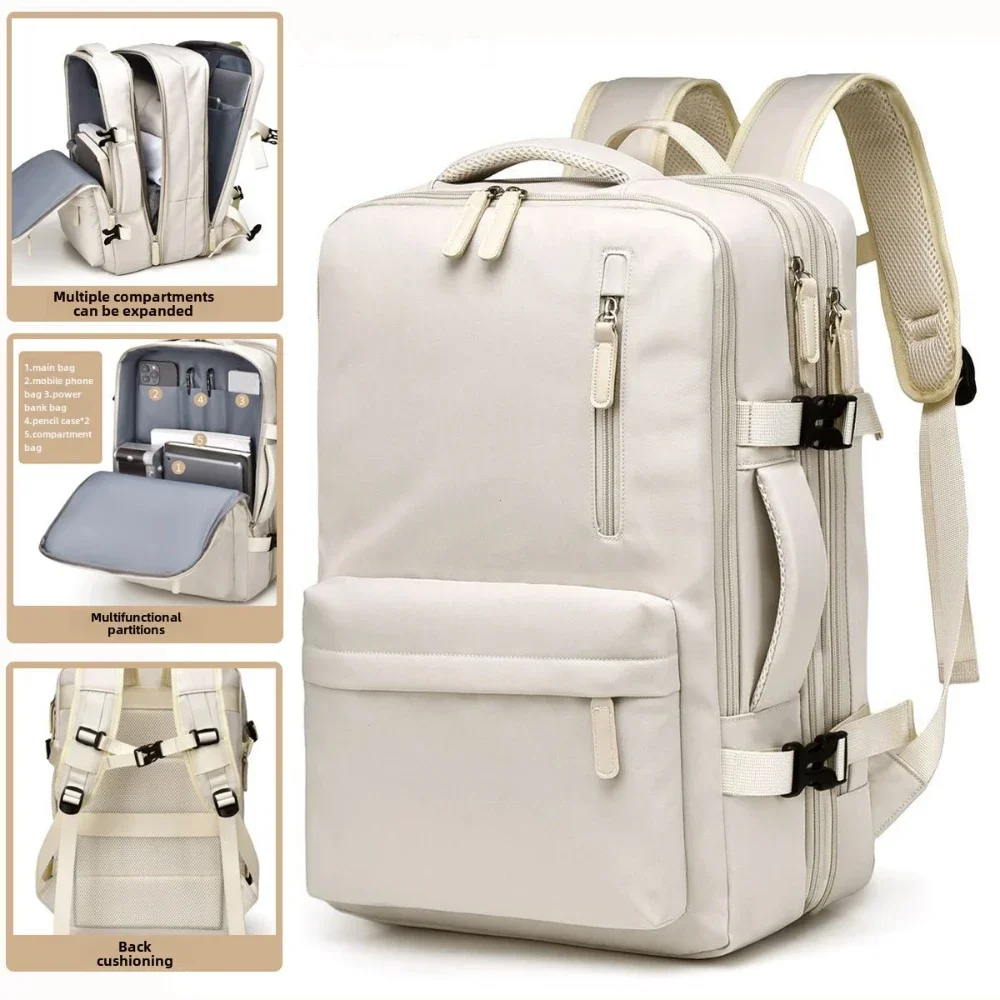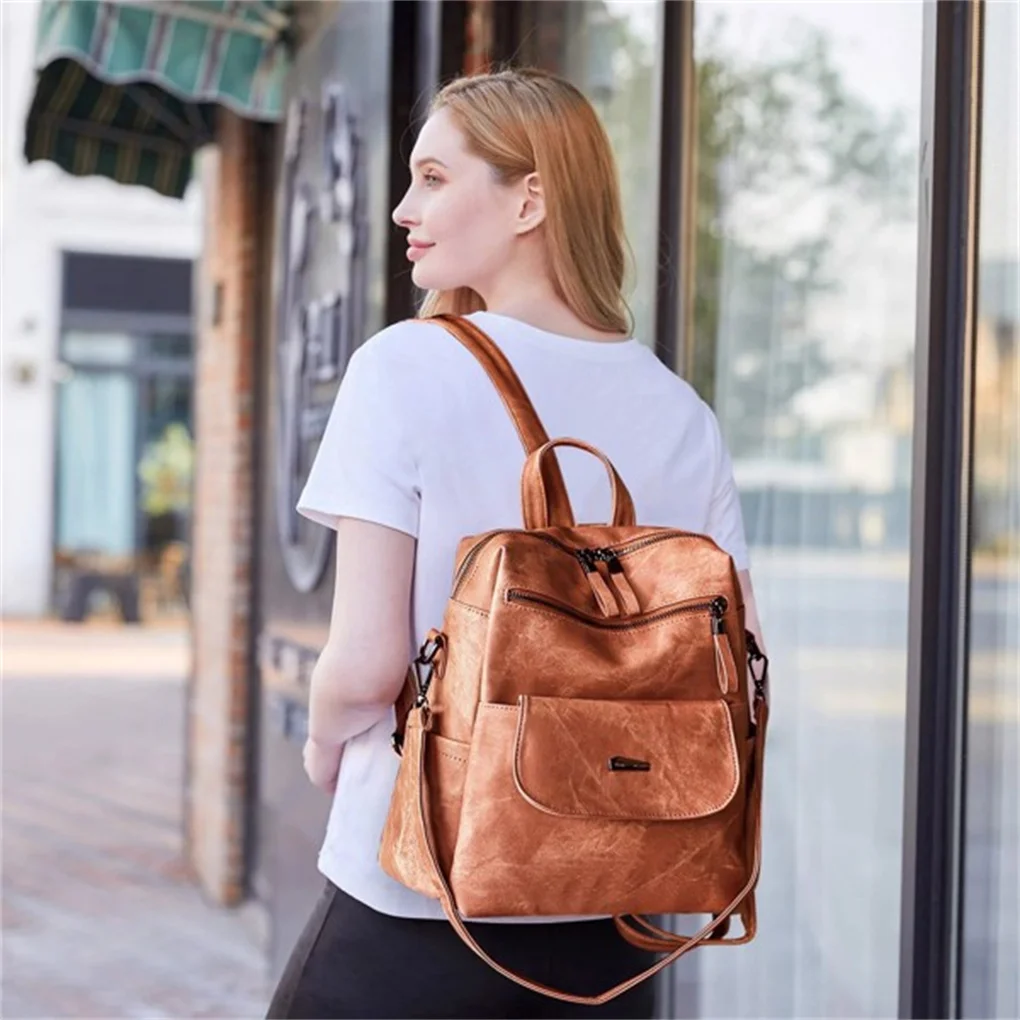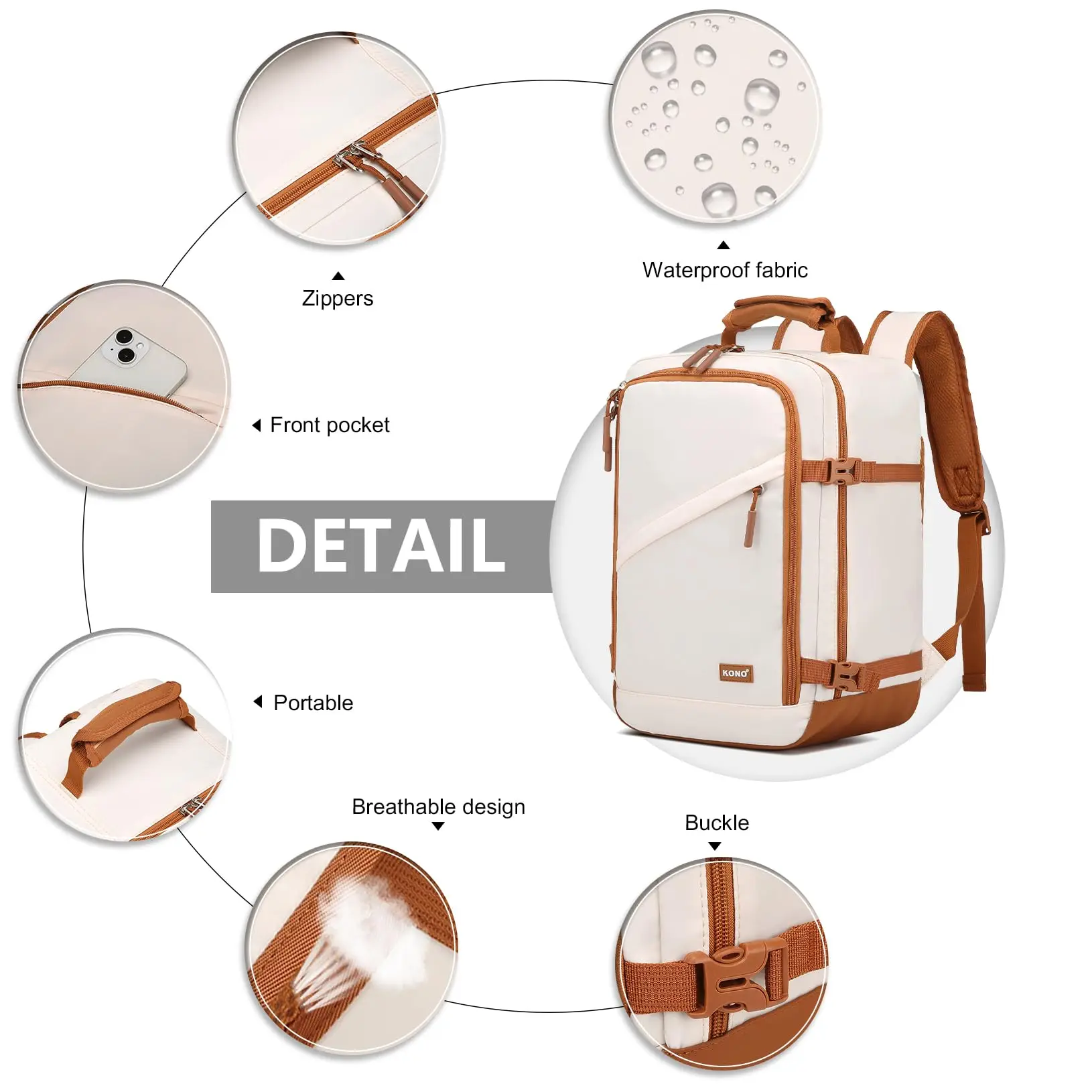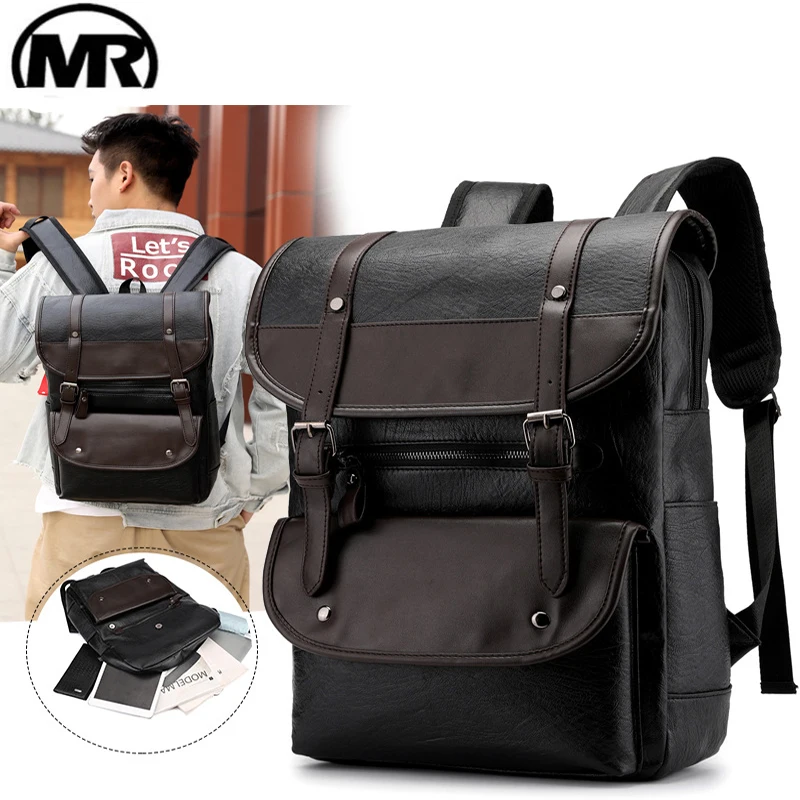Understanding Backpack Closure Systems
Backpacks serve as our daily companions in life’s journeys, whether commuting to work, exploring new cities, or embarking on wilderness adventures. Among the many design features that impact your experience, the closure system stands as perhaps the most fundamental choice: roll-top or zippered.
These two closure styles represent distinctly different approaches to backpack design, each with unique characteristics that influence:
- Weather protection capabilities
- Ease of access to your belongings
- Flexibility in storage capacity
- Overall durability and lifespan
- Aesthetic appeal and style
The choice between roll-top and zippered backpacks isn’t simply about preference—it reflects your priorities and specific needs. A commuter cycling through rainy city streets has different requirements than a professional accessing documents throughout the workday. Understanding these differences becomes crucial when investing in a quality backpack designed to last for years.
Proper leather conditioning and waterproofing can enhance both styles, but inherent design differences remain. Throughout this guide, we’ll examine the strengths, limitations, and ideal use cases for each closure system—helping you determine which style aligns best with your lifestyle.
What is a Roll-Top Backpack?
A roll-top backpack features a distinctive closure mechanism where the upper portion of the bag—typically made from flexible, durable fabric—extends beyond the main compartment. To close the bag, you fold or roll this extended material down several times, then secure it with buckles, straps, or hooks on the sides or front of the pack.
This design evolved from waterproof dry bags used in boating and water sports, where creating a watertight seal was critical. Over time, urban commuters and cyclists adopted this practical design for its weather resistance and adjustable capacity. The roll-top mechanism creates a simple but effective barrier against rain and moisture by eliminating the vulnerable seams and openings found in traditional closures.
Construction of quality roll-tops requires materials with the perfect balance of flexibility and durability. The top section must remain pliable enough to roll smoothly while withstanding repeated folding and unfolding. In premium leather versions, specially treated sections ensure the leather maintains its integrity through constant manipulation.
The aesthetic of roll-top backpacks tends toward minimalist and contemporary, with clean lines and reduced external features. This sleek profile has made them particularly popular among urban professionals and cyclists seeking functional style. Summit Carry’s roll-top leather backpacks combine this practical design with premium materials for those wanting both function and refined aesthetics.
What is a Zippered Backpack?
A zippered backpack uses—as the name suggests—zipper mechanisms as its primary closure system. These familiar interlocking teeth, operated by a slider, create secure openings that can be quickly closed or opened with a single motion. The zipper’s invention revolutionized backpack design by enabling complex compartmentalization and access configurations.
Quality zippered backpacks typically feature heavy-duty zippers (often YKK brand) designed to withstand thousands of open-close cycles without failing. Higher-end models may incorporate water-resistant or waterproof zippers with special coatings and covers that minimize water penetration through this vulnerable point.
Zippered backpacks come in several common configurations:
- Top-loading designs with a single main zipper at the top
- Panel-loading styles with zippers that extend down the sides for wider opening
- Clamshell designs that open completely like a suitcase for maximum access
This closure type allows for considerable design versatility. Backpacks can incorporate multiple compartments, specialized pockets, and access points positioned strategically around the bag. This complexity enables highly specialized organization systems tailored for specific uses like photography, tech carrying, or business needs.
Proper leather conditioning and maintenance is essential for zippered leather backpacks, as the material around high-stress zipper attachments requires special attention to prevent premature wear or cracking.
Weather Resistance Comparison
When it comes to keeping your belongings dry, the closure system plays a crucial role in a backpack’s weather resistance capabilities.
Roll-top backpacks excel in weather protection through their fundamental design. When properly rolled (typically 3-4 folds) and securely fastened, the folded material creates multiple layers of protection against water penetration. With no zipper teeth or seams at the top opening, there are simply fewer entry points for moisture. This design creates an inherently water-resistant barrier that performs exceptionally well in sustained rain conditions.
Zippered backpacks, by contrast, have a natural vulnerability at the zipper line. Standard zippers feature tiny spaces between teeth that can allow water to penetrate during heavy downpours. While many premium backpacks incorporate water-resistant zippers with protective flaps or coatings, these additions rarely match the water resistance of a properly secured roll-top closure.
Performance comparison in various conditions:
– Light rain: Both styles perform adequately with minimal water ingress
– Heavy downpour: Roll-tops significantly outperform standard zippered designs
– Submersion: Neither style is completely waterproof without specialized materials and construction
It’s worth noting that overall weather resistance depends on more than just the closure type. The complete guide to waterproofing leather bags shows how material treatment, seam construction, and additional protective elements contribute to weather protection regardless of closure style.
For those who frequently encounter wet conditions, this weather resistance advantage might be the deciding factor in favor of roll-top designs.
Accessibility and Convenience
Where zippered backpacks truly shine is in their accessibility—the ease and speed with which you can retrieve items from your bag.
Zippered designs offer nearly instantaneous access to contents through a simple pull motion. This quick-access capability becomes particularly valuable in situations requiring frequent retrieval of items throughout the day. Additionally, strategic zipper placement around the backpack enables direct access to specific compartments without disturbing other contents—ideal for grabbing a water bottle from a side pocket or accessing a laptop without unpacking other items.
Roll-top backpacks, while secure, require a multi-step process to access the main compartment:
1. Unbuckling or unclasping the security straps/hooks
2. Unrolling the top material (usually 3-4 rolls)
3. Opening the now-loosened top to reach inside
This process typically takes longer and often requires using both hands, which can be inconvenient when on the move or in crowded spaces. Many roll-top users describe a “black hole” effect where items at the bottom become difficult to locate without removing contents from above them.

Both designs have evolved to address their inherent limitations. Modern roll-top backpacks often incorporate supplementary zippered pockets for frequently needed items, while maintaining the weather-resistant main compartment. Understanding exactly how roll-top leather backpacks work can help you determine if this design meets your accessibility needs.
Storage Capacity and Flexibility
One of roll-top backpacks’ most distinctive advantages is their adjustable capacity—the ability to adapt to different load volumes depending on your needs.
Roll-top designs allow for variable capacity by simply adjusting how far down you roll the top closure. With minimal contents, you can roll the top down further, creating a compact profile. When carrying more items, you can use fewer rolls to accommodate the expanded volume. This flexibility can typically add 15-30% additional capacity compared to the backpack’s nominal size.
Zippered backpacks generally offer fixed capacity determined by the dimensions of the bag and the maximum extension of the zipper. While some designs incorporate expansion zippers to increase volume, most zippered backpacks maintain constant dimensions regardless of how full they are.
This adaptability makes roll-tops particularly well-suited for those with varying carry needs—perhaps carrying just essentials some days but needing extra space for gym clothes or groceries on others. Choosing the perfect backpack volume becomes less critical when your bag can adjust to different loads.
The trade-off for this flexibility often comes in terms of internal organization. Roll-tops typically feature a simpler, more open internal layout to maximize the benefits of their expandable design, while zippered backpacks often offer more structured organization systems with fixed dimensions.
Organization and Structure
The interior design philosophy differs significantly between these two backpack styles, impacting how you organize and access your belongings.
Zippered backpacks typically excel at organization through compartmentalization. Their design enables:
- Multiple separated compartments for different categories of items
- Purpose-built pockets for specific objects (pens, phones, wallets)
- Padded laptop sleeves integrated into the structure
- Admin panels with numerous small pockets for accessories
- Side and front pockets with their own dedicated zipper access
This structured approach keeps items separated and easily accessible, making zippered designs popular for everyday carry and work scenarios where organization is paramount.
Roll-top backpacks generally feature a more minimalist interior design, often with:
– A large main compartment with an open “bucket” design
– Fewer internal dividers to maximize the benefits of the expandable space
– Simple sleeve pockets along the back panel for flat items
– External pockets for quick-access items
This simpler organization requires different packing strategies, such as using packing cubes or pouches to group similar items. Understanding how to pack a backpack evenly becomes particularly important for comfort and accessibility with roll-top designs.
The choice between these organization philosophies often comes down to personal preference and specific use cases—some users prefer the simplicity and flexibility of an open compartment, while others value the structure and separation of a highly compartmentalized design.
Durability and Longevity
When investing in a quality backpack, understanding potential failure points helps predict longevity and maintenance requirements.
Zippered backpacks have their primary vulnerability in the zipper mechanism itself. Even high-quality zippers can eventually experience issues with:
– Teeth misalignment or damage from overpacking
– Slider separation or breakage from force or catching
– Pull tab detachment from repeated use
– Lubricant depletion causing rough operation
Quality zippers like YKK can last for many years with proper care, but they contain multiple small moving parts that can potentially fail.
Roll-top backpacks generally have fewer mechanical failure points in their closure system. Their durability concerns typically involve:
– Wear on buckles or clasps from repeated use
– Stress on attachment points where hardware connects to fabric
– Material fatigue along fold lines from repeated rolling
– Strap wear at adjustment points
The simpler mechanical nature of roll-top closures often results in fewer catastrophic failures—a worn strap or buckle can typically be repaired or replaced more easily than a failed zipper.

For both styles, regular leather maintenance for commuters helps preserve the material and extend the backpack’s lifespan. With proper care, premium backpacks of either closure type can provide many years of reliable service.
Security Considerations
The security provided by your backpack’s closure system can be an important consideration, particularly for urban use and travel.
Roll-top backpacks offer several security advantages:
– Multi-step opening process deters casual theft attempts
– No immediate or obvious access point when properly secured
– Often require two hands and multiple actions to fully open
– Typically make noise (velcro, buckle clicks) when being opened
– Can be secured with carabiners or locks through buckles for added protection
Zippered backpacks present different security considerations:
– Quicker to open, potentially allowing faster unauthorized access
– Zipper pulls can be secured together with small locks
– Hidden zipper designs can reduce visibility of access points
– More compartments allow valuables to be distributed and concealed
– Anti-theft designs may incorporate slash-resistant materials and locking hardware
For travelers, understanding the secure compartments in carry-on backpacks can help determine which security features best match your needs and concerns.
Neither style provides perfect security, but roll-tops generally require more time and effort to access without permission, potentially deterring opportunistic theft. However, zippered styles with security features may offer better specialized protection for high-risk environments.
Aesthetic and Style Factors
Beyond functionality, the closure system significantly influences a backpack’s aesthetic appeal and style statement.
Roll-top backpacks project a distinctive, modern aesthetic characterized by:
– Clean, minimalist lines with reduced external hardware
– Contemporary urban styling with architectural influences
– Technical outdoor-inspired design elements
– A unique silhouette that changes based on content and closure position
– Often associated with cycling culture and urban mobility
Zippered backpacks offer greater style diversity:
– Traditional academic and heritage designs
– Sleek professional styles for business environments
– Technical outdoor aesthetics with visible compartmentalization
– Vintage-inspired designs with modern functionality
– Greater variety in shape, profile, and visual complexity
Understanding different leather backpack styles can help you find the aesthetic that best complements your personal style and use cases.
Summit Carry offers premium options in both closure styles, maintaining consistent quality materials and craftsmanship while allowing customers to choose the design aesthetic that best suits their taste and functional requirements.
Best Use Cases for Roll-Top Backpacks
Roll-top backpacks particularly excel in the following scenarios:
• Commuting in unpredictable weather conditions
The superior water resistance makes roll-tops ideal for bicycle commuters, motorcycle riders, and pedestrians who regularly face rain, snow, or splashing from passing vehicles. The peace of mind knowing electronic devices and important documents stay dry is invaluable.
• Activities with varying capacity needs
Users who sometimes carry minimal items but occasionally need extra space benefit from the expandable nature of roll-tops. Weekend travelers who might return with souvenirs, commuters who pick up groceries after work, or students with fluctuating book and equipment needs appreciate this adaptability.
• Outdoor adventures with weather exposure
Hikers, kayakers, and outdoor enthusiasts who may encounter sudden weather changes find roll-tops provide better protection for their gear. The ability to compress the pack when contents diminish (after consuming food or water) is an additional benefit.
• Minimalist everyday carry
Those preferring simplified organization and a cleaner aesthetic often gravitate toward roll-tops. The reduction in external features creates a streamlined look suitable for both casual and more refined environments.

• Security-conscious urban navigation
Users concerned about theft in crowded urban environments appreciate the added security of a closure system that takes more time and effort to access without permission.
Best Use Cases for Zippered Backpacks
Zippered backpacks shine in these common scenarios:
• Professional environments requiring frequent access
Office workers, consultants, and professionals who need to retrieve documents, devices, or accessories throughout the workday benefit from the quick, one-handed access zippered designs provide. The ability to quickly grab items during meetings or while moving between locations improves workflow efficiency.
• Organized everyday carry with multiple categories of items
Those carrying diverse items—technology, personal care products, stationery, snacks—appreciate the compartmentalization of zippered backpacks. The ability to designate specific spaces for different categories reduces time spent searching for items and prevents contents from shifting together.
• Air travel and security checkpoints
Travelers passing through security screenings benefit from strategic zippered compartments that allow quick access to laptops, liquids, and documents without unpacking the entire bag. Panel-loading or clamshell designs are particularly valuable for hotel stays where full access to contents is desirable.
• Photography, tech, and specialized equipment
Users carrying cameras, multiple electronic devices, or specialized tools value purpose-built zippered compartments that provide protection and organization for specific items. Padded dividers and customizable spaces keep sensitive equipment secure.
• Formal business settings
Traditional zippered designs often present a more conventional, professional appearance suitable for conservative work environments where contemporary or technical-looking roll-tops might seem out of place.
Modern Hybrid Designs: Getting the Best of Both
As backpack design evolves, manufacturers have begun creating innovative hybrid solutions that combine the strengths of both closure systems while minimizing their respective weaknesses.
Modern hybrid approaches include:
- Roll-top main compartments with supplementary zippered pockets for frequently accessed items
- Quick-access side zippers that provide entry to the main compartment without opening the roll-top
- Water-resistant zippered designs with protective flaps and sealed seams
- Convertible systems that can be used in either roll-top or zippered configuration
- Magnetically-assisted roll-tops that simplify the closure process
These hybrid solutions acknowledge that many users have complex needs that aren’t perfectly addressed by traditional designs. By incorporating elements from both systems, these versatile backpacks adapt to different scenarios and preferences.
Premium materials enhance the performance of both closure types—high-quality leather, for example, can be treated to improve water resistance in zippered designs or engineered for flexibility in roll-tops. As manufacturing techniques advance, the historical limitations of each style continue to diminish.
Key Factors for Making Your Decision
When deciding between roll-top and zippered backpacks, consider these key questions to align the choice with your specific needs:
Primary Environment Considerations:
– Do you regularly encounter rain or snow during your commute?
– How important is protection from water or moisture for your carried items?
– Will your backpack be exposed to outdoor elements for extended periods?
Usage Pattern Assessment:
– How frequently do you need to access items throughout the day?
– Do you carry primarily consistent items or highly variable loads?
– Are you primarily using the backpack for work, travel, outdoor activities, or mixed use?
Organization Preferences:
– Do you prefer dedicated compartments for different items?
– Are you comfortable using packing cubes or pouches to organize an open space?
– How important is quick retrieval of specific items without searching?
Capacity Requirements:
– Do your carrying needs fluctuate significantly from day to day?
– Do you occasionally need to transport larger items?
– Is a consistent, predictable capacity more important than flexibility?
Aesthetic Priorities:
– Does your environment have specific style expectations (e.g., corporate office)?
– Do you prefer a more technical, modern look or traditional styling?
– How important is the backpack as a fashion accessory versus purely functional tool?
Rank these factors based on personal importance to clarify which closure system best aligns with your particular priorities and lifestyle.
Frequently Asked Questions
Are roll-top backpacks completely waterproof?
Roll-top backpacks provide excellent water resistance but aren’t typically 100% waterproof unless specifically designed with fully sealed seams and waterproof materials. Standard roll-tops will protect contents from rain and splashes but shouldn’t be submerged. For complete waterproofing, look for models specifically rated as waterproof rather than water-resistant.
How do I organize items in a roll-top backpack?
The open design of roll-top backpacks works well with organizational accessories like packing cubes, pouches, or organizer inserts. Place frequently accessed items near the top and use the bag’s side pockets for items needing quick access. Many users develop a “mental map” of where specific items are placed to overcome the lack of compartmentalization.
Can zippered backpacks be used for outdoor adventures?
Absolutely. Many outdoor-specific backpacks use zippered designs with additional weather protection features like zipper covers or water-resistant treatments. While they may not match roll-tops in extreme weather protection, quality zippered outdoor backpacks perform well in most conditions when properly maintained and treated.
Which style is better for carrying laptops and electronics?
Both styles can safely carry electronics with proper internal organization. Zippered backpacks typically offer dedicated laptop compartments with padding and easier access. Roll-tops can safely transport electronics (especially with a protective sleeve) and often provide better protection against unexpected rain. Consider your specific access needs and environmental conditions when deciding.
Do roll-top backpacks last longer than zippered ones?
Longevity depends more on material quality and construction than closure type alone. Roll-tops typically have fewer mechanical parts that can fail, while quality zippered backpacks with premium components (like YKK zippers) can last for many years. With proper care and maintenance, premium versions of either style should provide excellent durability.
Are there hybrid options that combine both closure types?
Yes, many modern backpacks incorporate elements of both designs—typically featuring a roll-top main compartment with supplementary zippered pockets for quick access. These hybrids aim to provide weather protection for the main contents while maintaining convenience for frequently accessed items.

